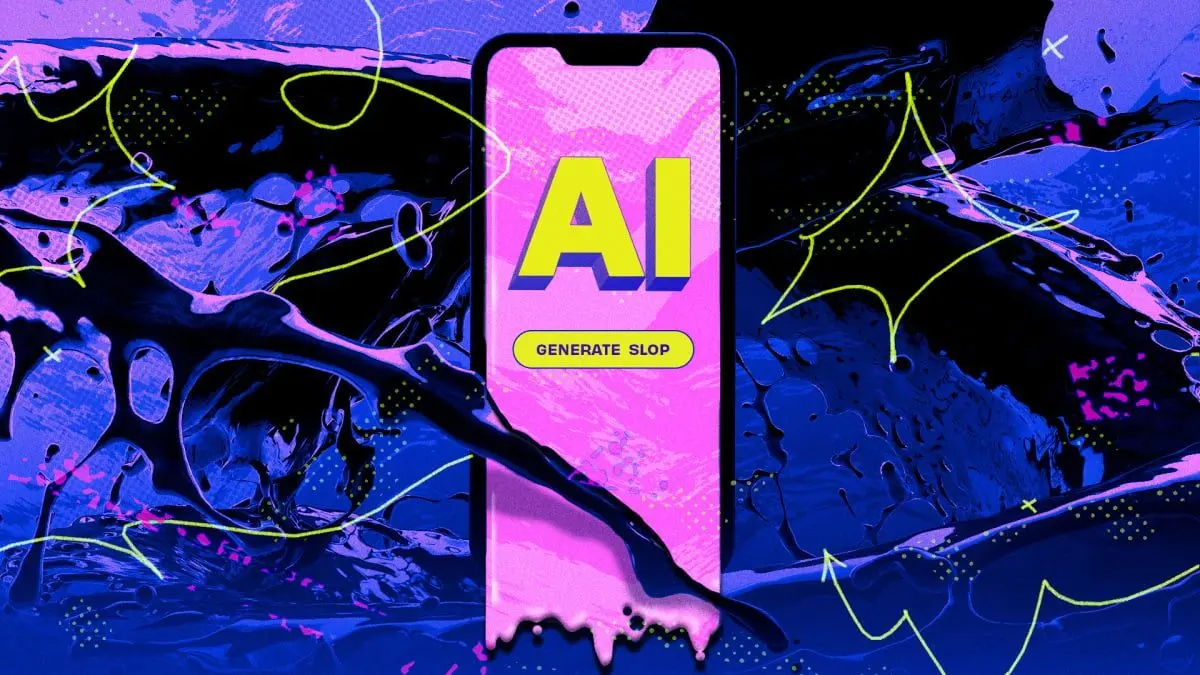The Rise of AI Slop: How Mass-Produced Content Is Degrading Social Media and Marketing
2 Sources
2 Sources
[1]
AI slop is taking over the internet. Here's how we got here.
Welcome to the era of AI slop Credit: Ian Moore / Mashable Composite; Hutangac / iStock / Getty If your feed is inundated with AI slop these days, you're not alone. "Slop" is a squishy, subjective term -- it depends entirely on what you think looks cheap, lazy, or low-effort. Still, the vibe people are describing tends to be the same: mass-produced content, shoddily plopped into the feed, neither discerning nor pleasurable. Why should AI output be any different than grayish cafeteria slop? Generative AI has been feeding social media since its inception, but the shift has recently become more pronounced. We've covered this great slopification at Mashable. Heck, there's a laundry list of just animal-based AI slop we've covered: fake animals "caught" on surveillance tapes, emotional support kangaroos, musicians with critter companions, or heavy machinery "cleaning" barnacles off whales. So, the obvious questions are: How much AI slop is there, really, and why? There's no definite way to know how much AI slop is out there, and your mileage may vary on what constitutes slop. For what it's worth, AI slop was defined by Quinnipiac University technologist Adam Nemeroff as "low-to mid-quality content -- video, images, audio, text or a mix -- created with AI tools, often with little regard for accuracy." And there has been some research conducted on AI-generated content online. Notably, SEO firm Graphite published a study last month that found 52 percent of articles online were generated by AI. Graphite CEO Ethan Smith said you could glean some knowledge about other types of content from the study. "Do I think that ad copy is generated with AI? There's probably a good amount of that," Smith told Mashable. "There's probably a lot of social media posts that are AI-generated." He added you'd probably see more AI-generated tweets -- text is easy to generate, after all -- and a medium level of AI content on platforms like Instagram and TikTok. Even if 52 percent of the internet were AI-generated content, that's at least below at least one expert's 2023 prediction that it'd be 90 percent by 2025. Still, it's prevalent enough that everyone with an internet connection has encountered AI-generated content out there that's obvious and, well, sloppy. Researchers at Amazon Web Services have found, for instance, that large swaths of the internet are poorly done, AI-generated translations. In other words, slop begets slop in different languages. It's clear that if you're not prompting chatbots carefully, the output remains subpar. It's why you see AI-generated comments that make no sense or trending videos with nonsensical, non-sequitur lists that really feel like AI. So, there's no exact figure for how much slop we're seeing, but you can certainly feel it. You notice swipe after swipe. "My suspicion would be that every person who is into social media, on average, when they open their phone and scroll one of these apps, they're going to see a slop reel," said Aidan Walker, an internet culture researcher. AI slop is everywhere because it's easy to create, and because "slop" in this context describes content made fast, at scale, with little risk or care. "Because there is such a low bar to entry, it kind of made it a lot more possible for people not just to produce content, but to produce it at volume," Walker said. "Take a bunch of shots at the target and, inevitably, if you post 100 videos, one or two of them are going to get some traction." Not that social media was ever a sacred space -- though there was a time it was good -- but we should consider what that much AI slop does to our collective online experience. What becomes of a platform that requires you to wade through mountains of junk to find the jewels? "The proliferation of this slop and the opportunity cost of it -- the real estate, the mind-share it takes up on a platform -- that's the danger," Walker said. "It degrades these online spaces." Consider people's complaints about what AI has done to the quality of Google search, and then extrapolate that to your website of choice. That's not to say all AI-generated social content is bad. AI can make memes in a snap or generate a voice clip for a joke. The tool is neutral; the intention behind the output is what shapes its quality. Lots of slop is created by people hustling for a dollar. Its content is meant to fool you just long enough to grab a sliver of your attention. It's a commodity, not a craft. And crucially, labeling it "slop" is about how it feels to the viewer, not some objective failing. "Nobody's really a fan of these AI slop accounts. They all blend together," Walker said. And that's the real sensation of a feed overwhelmed with AI-generated content. It blends. It blurs. It feels grabby but artless -- a morass, a muck. In a word, for many people, slop.
[2]
The rise of AI slop in marketing
AI slop has become a cultural warning sign. The phrase describes the flat, awkward feel of content created without human craft. The phrase came into sharp focus in August 2025 when J. Crew teamed up with Vans on a sneaker launch. The collection had all the right ingredients but included images that appeared strange and artificial. Shoppers quickly pointed out distorted hands, warped shadows, and robotic body poses. Instead of generating buzz, the release became a meme, proving how quickly audiences call out work that feels empty. This moment reflects a much larger shift. As brands rush to embrace automation, they often inundate audiences with content that may be fast and efficient, but lacks personality. AI delivers real advantages in speed and volume, but brands soon learn it's challenging to utilize while preserving credibility and emotional impact.
Share
Share
Copy Link
AI-generated 'slop' content is flooding social media platforms and marketing campaigns, creating low-quality, mass-produced material that degrades online experiences. From fake animal videos to corporate marketing failures, this phenomenon represents a growing challenge for digital platforms and brand authenticity.
The Emergence of AI Slop
The internet is experiencing an unprecedented flood of AI-generated content that users are increasingly describing as "slop" – a term that captures the cheap, lazy, and low-effort nature of mass-produced digital material. This phenomenon has become so pervasive that researchers and internet culture experts are sounding alarms about its impact on the quality of online experiences
1
.Quinnipiac University technologist Adam Nemeroff defines AI slop as "low-to mid-quality content -- video, images, audio, text or a mix -- created with AI tools, often with little regard for accuracy." The term has gained traction as users across platforms encounter increasingly obvious examples of AI-generated content that feels neither discerning nor pleasurable
1
.
Source: Mashable
The Scale of the Problem
Recent research reveals the staggering extent of AI-generated content online. A study by SEO firm Graphite found that 52 percent of articles on the internet are now generated by AI, with CEO Ethan Smith suggesting that social media posts and advertising copy likely follow similar patterns. While this figure falls short of some experts' 2023 prediction that 90 percent of internet content would be AI-generated by 2025, it represents a significant shift in the digital landscape
1
.Internet culture researcher Aidan Walker observes that the prevalence has reached a tipping point: "My suspicion would be that every person who is into social media, on average, when they open their phone and scroll one of these apps, they're going to see a slop reel." This ubiquity stems from the low barrier to entry for AI content creation, enabling creators to produce material at unprecedented volume and speed
1
.Corporate Marketing Missteps
The corporate world has not been immune to the AI slop phenomenon, with high-profile brands facing public backlash for poorly executed AI-generated marketing materials. A notable example occurred in August 2025 when J. Crew partnered with Vans on a sneaker launch that included images with obvious AI artifacts – distorted hands, warped shadows, and robotic body poses. Rather than generating excitement, the campaign became a viral meme, demonstrating how quickly audiences can identify and reject inauthentic content
2
.This incident reflects a broader challenge facing brands as they rush to embrace automation while struggling to maintain credibility and emotional impact. While AI offers undeniable advantages in speed and volume, companies are learning that these benefits come at the cost of authenticity when not carefully managed
2
.Related Stories
The Degradation of Digital Spaces
The proliferation of AI slop extends beyond individual annoyance to broader concerns about the degradation of online environments. Walker warns about the "opportunity cost" of this content: "The real estate, the mind-share it takes up on a platform -- that's the danger. It degrades these online spaces." The comparison to how AI has affected Google search quality provides a sobering preview of what might happen to other digital platforms
1
.The content creation strategy behind much AI slop involves a volume-based approach where creators "take a bunch of shots at the target," posting hundreds of videos in hopes that one or two gain traction. This spray-and-pray methodology floods platforms with content designed to grab attention momentarily rather than provide genuine value or entertainment
1
.References
Summarized by
Navi
[2]
Related Stories
AI Slop: The Rise of Low-Quality AI-Generated Content Flooding the Internet
03 Sept 2025•Technology

AI 'Workslop' Plagues Companies, Hampering Productivity and Team Dynamics
23 Sept 2025•Business and Economy

The Rise of 'AI Slop': How Artificial Intelligence is Flooding Social Media with Fake Content
29 May 2025•Technology

Recent Highlights
1
Google launches Gemini 3 Flash as default AI model, delivering speed with Pro-grade reasoning
Technology

2
OpenAI launches GPT Image 1.5 as AI image generator war with Google intensifies
Technology

3
OpenAI launches ChatGPT app store, opening doors for third-party developers to build AI-powered apps
Technology





